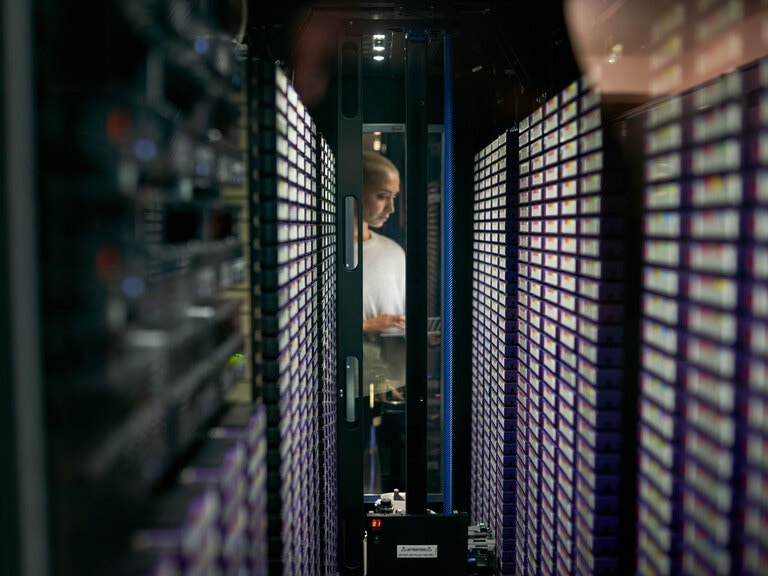The use of artificial intelligence (AI) in defence is highly controversial and poses more questions than it answers. But as technologies become more sophisticated, it could become a key part of military operations.
- Military AI expected to grow at a CAGR of 11.7% between 2023 and 2028.
- Demand from government agencies for AI boosts Palantir’s investment case.
- How to invest in military AI: the HanETF Future of Defence ETF is up 3% since its launch.
The war in Ukraine passed the 500-day mark in mid-July. As the fighting continues, weapons are becoming more sophisticated in order to inflict damage on infrastructure and morale. Among the technologies that militaries have deployed are drones and autonomous weapon systems.
Global expenditure on military AI and autonomous systems was approximately $6.9bn last year and is forecast to grow at a CAGR of 11.7% between 2023 and 2028, by which time the market could be valued at $13.2bn, according to a June report published by The Insight Partners.
Continued advances in military AI are likely to raise the risk of conflict between the US and China, warned the Centre for a New American Security last month. “China provides little transparency on its military modernisation efforts, including for AI, which could someday lead to strategic surprise for the US if Beijing manages to make breakthroughs in secret,” it stated in a report.
In a six-page dossier submitted to a House of Lords committee in May, an anonymous expert wrote that the “breathtaking” speed of military AI development and “the headlong rush to keep developing” should leave us under no illusion that the technology poses “unfathomable risk”.
“Under no circumstances should thinking machines, whose power is barely understood, be integrated into the defence of the realm or given the freedom to kill,” warned the expert.
It should be emphasised that an autonomous weapon, or a drone that requires a human to programme and activate it, is different from AI-powered machines or an army of AI robots that take full authority over whether to carry out a strike.
Companies making advances in military AI
Virginia-based defence contractor AeroVironment [AVAV] has been supplying Ukraine with SwitchBlade 300 kamikaze drones, which are said to have been making a significant impact in the country’s current counteroffensive. The company signed a $64.6m contract with the US Army in April for SwitchBlade 300s, taking the total value of its long-term partnership with the US Army to $231.3m.
Earlier this year, the Australian division of defence giant BAE Systems [BA.L] unveiled the prototype of its Strix drone, which could “act as a ‘loyal wingman’ for military helicopters” in supporting air-to-ground munition strikes and surveillance. Assuming that testing goes smoothly, Strix could be launched in 2026, according to BAE Australia CEO Ben Hudson.
In April, Palantir [PLTR] launched its Artificial Intelligence Platform (AIP), a programme that uses large language models for military decision-making and “bending AI to our collective will”, according to a shareholder letter from CEO Alex Karp. On the Q1 2023 earnings call in May, chief business affairs and legal officer Ryan Taylor said that the company was seeing “unprecedented demand” for AIP.
From R&D to operational capability
There are currently many proofs of concept for the deployment of AI in the defence sector. Possible applications include detecting imminent equipment failure and automating defensive weapon response.
The next step will be to find ways to turn these “R&D concepts into operational capabilities being used and trusted by defence users,” according to David Henstock, chief data scientists at BAE Systems’ digital intelligence division.
“Even when we have a great technology solution, we need to make it robust enough to manage the scale and complexities of operational scenarios and get it onto users’ platforms in a reliable, assured and responsible way,” wrote Henstock in a blog post published in July.
Technological advances to accelerate AI adoption
Last December, the UK Ministry of Defence awarded Palantir a three-year $75m contract that will see the software company help the UK government department to “exploit data at scale” and “deliver superior military advantage and greater efficiency across the enterprise, from headquarters to the front lines”.
Advances in military AI and an increase in cyber warfare will likely increase demand from government departments and agencies for intelligent platforms like Palantir’s to protect their infrastructure, troops and resources.
According to Wedbush analyst Dan Ives, who initiated coverage of the stock with an ‘outperform’ rating at the end of last month, investors are underestimating the company’s long-term potential. “In a nutshell, we believe Palantir has built an AI fortress that is unmatched and poised to be a major player in this AI revolution over the next decade,” tweeted Ives.
Robust governance will be needed
If military AI continues to develop at its current pace, however, it might not be long before the concept of an army of AI robots that kill becomes a terrifying reality. This would call for robust governance to ensure that AI is being used safely, responsibly and in line with national defence policies. There have even been calls for the training of AI models to be paused to address ethical concerns.
Yet there could be pushback. In his letter announcing AIP, Palantir CEO Karp warned against “a pause on efforts to develop even more powerful versions of these emerging technologies”. It’s unrealistic to expect “adversaries will join us in considered reflection on the capabilities of such systems and their accompanying risks”. Pausing development would leave countries who do so more vulnerable to attacks, concluded Karp.
How to invest in military AI
ETFs, or exchange-traded funds, offer an economical and diversified way to invest in a variety of stocks within a particular theme.
Funds in focus: the HanETF Future of Defence ETF
There are no ETFs focused specifically on military AI and technology, but some funds offer indirect exposure.
The HanETF Future of Defence ETF [NATO.L], which was launched in early July, offers exposure to companies generating revenue from defence and cybersecurity defence spending by NATO members and their allies. It currently holds AeroVironment, BAE Systems and Palantir and the EQM Future of Defence Index it tracks is split weighted 52% to information technology (IT) and 48% to industrials.
NATO.L is up 3% since its launch through 31 July, according to the fund’s website.
“The world has entered a new period of geopolitical instability and as a result defence spending, both hardware and cyber focused, has risen and is set to rise further,” Jane Edmondson, CEO of EQM Indexes (the index provider for NATO.L), told Opto. She added that “the Future of Defence UCITS ETF provides exposure to this growth” restricted to “geopolitically responsible actors” within the NATO alliance.
The VanEck Defense UCITS ETF [DFNS.L] holds AeroVironment and Palantir. As of 31 July, industrials account for 89.2% of the portfolio, while IT has a weighting of 10.7%. The fund is up 18.8% since its launch on 31 March.
The iShares US Aerospace & Defense ETF [ITA], which holds AeroVironment, is more or less a pure-play on the sector. Aerospace and defence accounts for 97.51% of portfolio holdings, while 1.90% has been allocated to industrial machinery, supplies and components and leisure products have a 0.46% weighting as of 4 August. The fund is up 3.3% in the past six months.
Disclaimer Past performance is not a reliable indicator of future results.
CMC Markets is an execution-only service provider. The material (whether or not it states any opinions) is for general information purposes only, and does not take into account your personal circumstances or objectives. Nothing in this material is (or should be considered to be) financial, investment or other advice on which reliance should be placed. No opinion given in the material constitutes a recommendation by CMC Markets or the author that any particular investment, security, transaction or investment strategy is suitable for any specific person.
The material has not been prepared in accordance with legal requirements designed to promote the independence of investment research. Although we are not specifically prevented from dealing before providing this material, we do not seek to take advantage of the material prior to its dissemination.
CMC Markets does not endorse or offer opinion on the trading strategies used by the author. Their trading strategies do not guarantee any return and CMC Markets shall not be held responsible for any loss that you may incur, either directly or indirectly, arising from any investment based on any information contained herein.
*Tax treatment depends on individual circumstances and can change or may differ in a jurisdiction other than the UK.
Continue reading for FREE
- Includes free newsletter updates, unsubscribe anytime. Privacy policy






